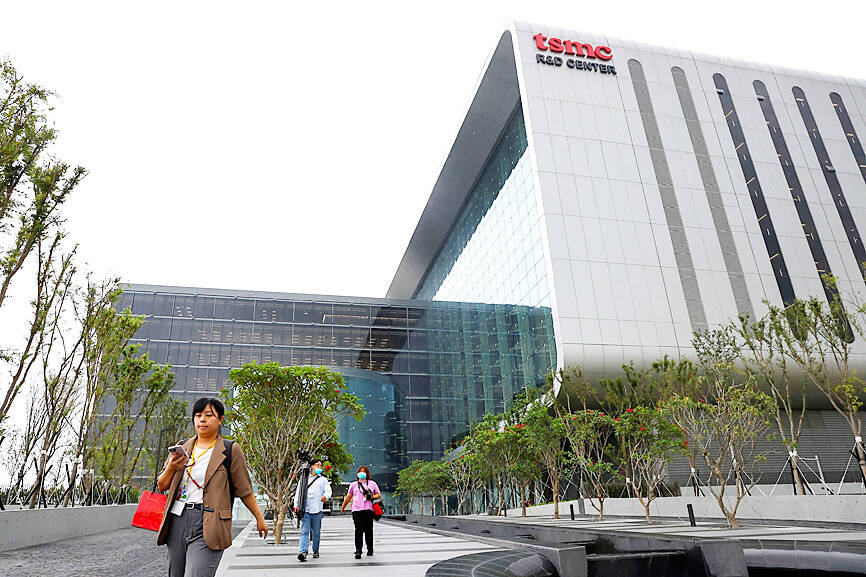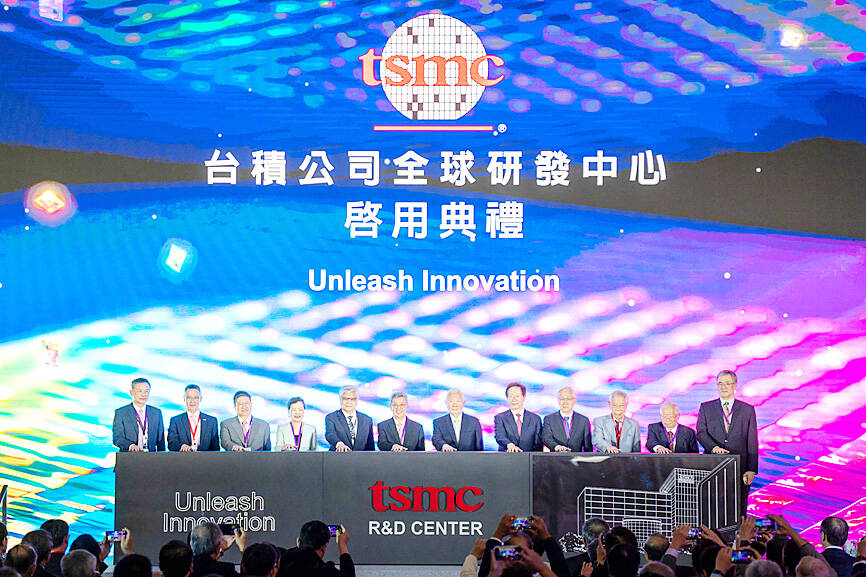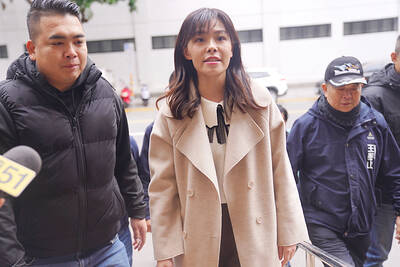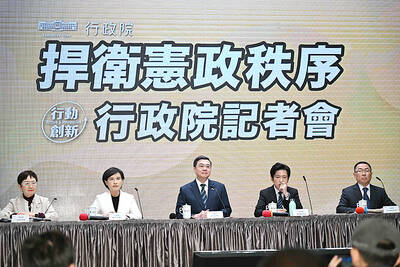Taiwan Semiconductor Manufacturing Co (TSMC, 台積電) yesterday inaugurated its new global research-and-development (R&D) center in Hsinchu to further its development of next-generation technologies, including 2-nanometer and beyond, as the world’s biggest contract chipmaker seeks to safeguard its global technology leadership.
The launch of the R&D hub demonstrates the chipmaker’s long-term commitment to investing in Taiwan and its determination to keep its roots at home, TSMC chief executive officer C.C. Wei (魏哲家) said in a speech at the inauguration.
Wei made the remarks amid concern about TSMC’s acceleration in expanding its global manufacturing footprint to the US and Japan in recent years.

Photo: Ann Wang, Reuters
The chipmaker is also considering building a fab in Germany to produce 28-nanometer chips used in vehicles in collaboration with its customers.
While TSMC’s overseas investments have sparked worries that the company might halt its development in Taiwan, Wei said that is not the case.
TSMC is expanding its overseas capacity with an aim to meet its customers’ needs, he said.

Photo: AFP / TSMC
The company expects the new R&D center to house more than 7,000 R&D engineers at full capacity by September, up from 2,200 people currently, it said.
“With the launch of the new global R&D center, TSMC will be more proactive in developing world-leading semiconductor technologies from 2-nanometer technology, 1.4-nanometer technology and smaller technologies,” TSMC chairman Mark Liu (劉德音) said.
The company said that its 2-nanometer technology would be the world’s most advanced when it is introduced in 2025, duplicating its success in bringing its 3-nanometer technology to market ahead of its competitors.
Counting Apple Inc and Nvidia Corp among its major customers, TSMC commands about a 60 percent share of the global semiconductor market.
The chipmaker said continuous investment in leading-edge technologies is the key to safeguarding its technological leadership. Last year, TSMC spent 30 percent more on R&D, totaling US$5.47 billion, compared with US$4.47 billion in 2021.
Since the company’s inception more than 30 years ago, TSMC has been determined to build its own technology, TSMC founder Morris Chang (張忠謀) said yesterday.
It was a long road for TSMC to fulfill that goal and become a global semiconductor technology leader, he said, adding that the company secured its technological leadership only after it introduced its 7-nanometer technology.
For more than 20 years, TSMC has heavily invested in R&D efforts by allocating 8 percent of its total revenue to it, Chang said.
Last year, TSMC’s R&D spending greatly surpassed the US$2 billion spent by the Massachusetts Institute of Technology, he said.

The US government has signed defense cooperation agreements with Japan and the Philippines to boost the deterrence capabilities of countries in the first island chain, a report by the National Security Bureau (NSB) showed. The main countries on the first island chain include the two nations and Taiwan. The bureau is to present the report at a meeting of the legislature’s Foreign Affairs and National Defense Committee tomorrow. The US military has deployed Typhon missile systems to Japan’s Yamaguchi Prefecture and Zambales province in the Philippines during their joint military exercises. It has also installed NMESIS anti-ship systems in Japan’s Okinawa

‘WIN-WIN’: The Philippines, and central and eastern European countries are important potential drone cooperation partners, Minister of Foreign Affairs Lin Chia-lung said Minister of Foreign Affairs Lin Chia-lung (林佳龍) in an interview published yesterday confirmed that there are joint ventures between Taiwan and Poland in the drone industry. Lin made the remark in an exclusive interview with the Chinese-language Liberty Times (the Taipei Times’ sister paper). The government-backed Taiwan Excellence Drone International Business Opportunities Alliance and the Polish Chamber of Unmanned Systems on Wednesday last week signed a memorandum of understanding in Poland to develop a “non-China” supply chain for drones and work together on key technologies. Asked if Taiwan prioritized Poland among central and eastern European countries in drone collaboration, Lin

BACK TO WORK? Prosecutors said they are considering filing an appeal, while the Hsinchu City Government said it has applied for Ann Kao’s reinstatement as mayor The High Court yesterday found suspended Hsinchu mayor Ann Kao (高虹安) not guilty of embezzling assistant fees, reducing her sentence to six months in prison commutable to a fine from seven years and four months. The verdict acquitted Kao of the corruption charge, but found her guilty of causing a public official to commit document forgery. The High Prosecutors’ Office said it is reviewing the ruling and considering whether to file an appeal. The Taipei District Court in July last year sentenced Kao to seven years and four months in prison, along with a four-year deprivation of civil rights, for contravening the Anti-Corruption

NO CONFIDENCE MOTION? The premier said that being toppled by the legislature for defending the Constitution would be a democratic badge of honor for him Premier Cho Jung-tai (卓榮泰) yesterday announced that the Cabinet would not countersign the amendments to the local revenue-sharing law passed by the Legislative Yuan last month. Cho said the decision not to countersign the amendments to the Act Governing the Allocation of Government Revenues and Expenditures (財政收支劃分法) was made in accordance with the Constitution. “The decision aims to safeguard our Constitution,” he said. The Constitution stipulates the president shall, in accordance with law, promulgate laws and issue mandates with the countersignature of the head of the Executive Yuan, or with the countersignatures of both the head of the Executive Yuan and ministers or